🪴Sprout 🙂Agree 🟡Consideration 📊Project 🛠️BringingLifeintotheWorld
The Big Idea
I want to plant a tea garden. Tea has long been something that I enjoy and fascinates me. Making Tea
Similar Ideas: LCOS Facility Pattern Language Plant Care Plants Around Church
A potential Design Pattern for a similar kind of Garden: Wild Edible Garden Design Pattern
Plant Databases
-
Plants for a Future - Plant uses and care
-
Calscape - Search Native California Plants
Place to Buy Seeds and Plants
Plants Nurseries Near By
https://www.laspilitas.com/stores/santa-margarita - Specializes in Native Plants
https://www.cambrianursery.com/nursery/ - Very large selection and even offer gardening classes
M and A Nursery
Growing Grounds Farm Santa Maria
https://polyplantshop.com/ - Connected with Cal Poly
https://manzanitanursery.com/ In solvang
Tips on Harvesting and Drying Herbs and Produce
Getty Stewart - Home Economist
Unorganized Resource Websites
gardening-tips-for-the-california-central-coast-a-guide-from-cambria-nursery/
https://www.latimes.com/home/la-lh-tea-plants-how-to-grow-20130318-story.html
easy-edibles-for-the-california-central-coast-food-forest-part-1
https://california101guide.com/edibleandmedicinalherbs/
https://www.cnps.org/gardening/garden-qa-edible-native-plants-for-the-home-garden-12580
https://arboretum.ucsc.edu/pdfs/ethnobotany-webversion.pdf
Growing Traditional Tea Plant (Camellia sinensis)
While the Mediterranean climate of Orcutt, California, with its warm, dry summers and mild, wet winters, isn’t the ideal climate for traditional tea plants (Camellia sinensis), it might be possible to grow certain varieties with careful selection and attention to their specific needs.
Challenges of Growing Tea in a Mediterranean Climate:
- Water Availability: Traditional tea plants prefer consistent rainfall and high humidity, which can be a challenge during Orcutt’s dry summers.
- Soil Acidity: Tea plants thrive in acidic soil (pH 4.5-5.5), and California soils can vary, often being more neutral or even alkaline.
Potential Tea Plant Varieties for Orcutt (with caveats): Given these challenges, you’ll want to focus on more resilient varieties and be prepared to provide specific care. Here are some possibilities to explore:
- Camellia sinensis sinensis: This variety is generally considered more cold-hardy than Camellia sinensis assamica (which prefers hotter, more humid conditions). It might have a better chance of tolerating the milder winters in Orcutt. Within this variety, look for cultivars known for their hardiness.
- Yabukita: A popular Japanese cultivar known for its good flavor and adaptability. It might be worth trying.
- Benishibuki: Another Japanese cultivar that is reported to be relatively hardy.
- Camellia sinensis ‘Makura-yama’: This Japanese cultivar is sometimes mentioned as being more adaptable to a wider range of conditions.
- Hybrids and Experimentation: Some tea growers in California and other non-traditional regions are experimenting with various hybrids. You might find some smaller nurseries or tea enthusiasts in the state who have had success with specific cultivars adapted to the local conditions.
Key Considerations for Growing Tea Plants in Orcutt:
- Soil Amendment: You will likely need to amend your soil to increase acidity. This can be done with peat moss, sulfur, or other acidifying amendments. Regular testing of your soil pH is crucial.
- Watering: Consistent watering, especially during the dry summer months, will be essential. Consider using drip irrigation to conserve water and provide it directly to the roots. You might also need to provide some shade during the hottest part of the day to reduce water stress.
- Protection from Harsh Conditions: Protect young plants from strong winds and intense afternoon sun, especially during their establishment phase.
- Microclimate: Consider the specific microclimate in your garden. Areas with some afternoon shade and slightly higher humidity might be more suitable.
- Patience: Growing tea in a non-traditional climate can be a learning process. Be prepared for some trial and error.
Where to Find Tea Plants:
- Specialty Nurseries: Look for nurseries specializing in rare or unusual plants, or those that focus on tea plants specifically. You might need to order online.
- Local Horticultural Societies: Connect with local gardening groups or horticultural societies. They might have members with experience growing tea in your area.
Important Note: While it might be possible to grow some Camellia sinensis in Orcutt, it’s important to have realistic expectations. The yield and flavor profile might differ from teas grown in traditional regions. You might find more reliable success and a wider variety of flavors by focusing on the herbal teas mentioned in the list below, which are generally better suited to the Mediterranean climate.
Potential Herb Plants for a Mediterranean Climate
This list consolidates potential plants for a tea garden, suitable for a Mediterranean climate like the California Central Coast.
Anise Hyssop
Name: Agastache foeniculum - (Pursh.)Kuntze.
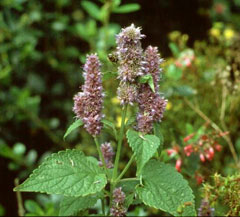 Description: Native to the mint family, anise hyssop has a licorice-like flavor.
Growing Conditions: Prefers full sun to partial shade and well-drained soil. Drought-tolerant once established.
Tea Usage: The leaves and flowers can be used fresh or dried for a sweet, licorice-flavored tea. Known for its digestive benefits.
Description: Native to the mint family, anise hyssop has a licorice-like flavor.
Growing Conditions: Prefers full sun to partial shade and well-drained soil. Drought-tolerant once established.
Tea Usage: The leaves and flowers can be used fresh or dried for a sweet, licorice-flavored tea. Known for its digestive benefits.
Basil
African Blue Basil
Name: Ocimum kilimandscharicum × basilicum ‘Dark Opal’ Description: A gorgeous perennial basil for the coastal California food forest. Its leaves are a bit spicier than annual sweet basils, with pretty little purple flowers that are edible too. Growing Conditions: Likes full sun and is drought tolerant once established. Tea Usage: Leaves can be used fresh or dried for a spicy, aromatic tea. The flowers are also edible and make a pretty garnish.
Culinary Basil
Name: Ocimum basilicum Description: The classic sweet basil commonly used in cooking. Growing Conditions: Prefers full sun and rich, moist, well-drained soil. Not as drought-tolerant as other varieties. Tea Usage: Fresh or dried leaves make a refreshing tea with anti-inflammatory properties.
Tulsi, Holy Basil
Name: Ocimum tenuiflorum Description: Known for medicinal benefits. Packs a flavorful punch with notes of clove, anise, and peppery spice. Growing Conditions: Thrives in full sun and well-drained soil. More heat-tolerant than culinary basil. Tea Usage: Considered an adaptogenic herb, traditionally used in Ayurvedic medicine. Makes a spicy, aromatic tea with potential stress-relieving properties.
Bergamot / Bee Balm
Bergamot, Scarlet beebalm, Horsemint, Oswego Tea, Bee Balm
Name: Monarda didyma
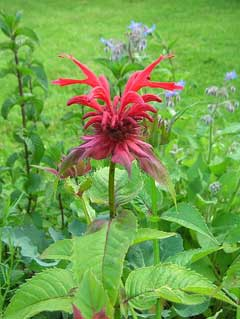 Description: Vibrant red flowers that attract pollinators. Growing Conditions: Prefers moist, rich soil and partial shade, though can tolerate full sun with adequate moisture. Tea Usage: Leaves and flowers make a tea with a strong citrus-mint flavor, similar to Earl Grey tea.
Description: Vibrant red flowers that attract pollinators. Growing Conditions: Prefers moist, rich soil and partial shade, though can tolerate full sun with adequate moisture. Tea Usage: Leaves and flowers make a tea with a strong citrus-mint flavor, similar to Earl Grey tea.
Wild Bergamot, Mintleaf bergamot, Wild Bee-Balm, Lupine
Name: Monarda fistulosa
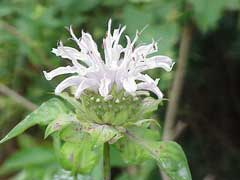 Description: Aromatic leaves and flower heads can be used to make a refreshing, slightly bitter mint-flavored tea. Growing Conditions: More drought-tolerant than M. didyma, preferring drier, well-drained soils and full sun to partial shade. Tea Usage: Indigenous peoples of California traditionally used it to treat stomach upset, respiratory problems, and sore throats.
Description: Aromatic leaves and flower heads can be used to make a refreshing, slightly bitter mint-flavored tea. Growing Conditions: More drought-tolerant than M. didyma, preferring drier, well-drained soils and full sun to partial shade. Tea Usage: Indigenous peoples of California traditionally used it to treat stomach upset, respiratory problems, and sore throats.
Blue Elderberry
Name: Sambucus cerulea (Flowers only): Description: A native shrub to tree with clusters of creamy white flowers and blue berries. Growing Conditions: Adaptable to various soil conditions, prefers partial shade to full sun and moderate moisture. Tea Usage: Use flowers only for tea. Elderflower tea is often enjoyed regularly for its pleasant flavor and potential immune-boosting properties. Be absolutely sure to only use the flowers.
Blue Vervain
Name: Verbena hastata Description: Tall perennial with slender purple-blue flower spikes. Growing Conditions: Prefers moist soil and full sun to partial shade. Tea Usage: The leaves and flowering tops can be used to make a slightly bitter tea traditionally used for relaxation and nervous system support.
Borage
Name: Borago officinalis Description: Annual herb with bright blue star-shaped flowers and fuzzy leaves. Growing Conditions: Prefers well-drained soil and full sun, self-seeds readily. Tea Usage: The leaves and flowers have a mild cucumber flavor and can be used fresh for tea. Traditionally used to support adrenal function.
Calendula
Name: Calendula officinalis Description: Annual or short-lived perennial with bright orange or yellow daisy-like flowers. Growing Conditions: Thrives in full sun and well-drained soil, tolerates poor soil conditions. Tea Usage: The petals can be used fresh or dried for a mildly sweet tea with skin-healing properties.
California Sagebrush, Coastal sagebrush, California sagewort
Name: Artemisia californica Description: Native California aromatic shrub with finely divided gray-green leaves. Growing Conditions: Prefers full sun and dry, well-drained soils, even tolerating poor, rocky conditions. It is highly drought-tolerant once established and requires minimal watering. Hardy in USDA zones 7-9 and 14-24. Tea Usage: The aromatic leaves were traditionally used by Native Americans to make tea for various medicinal purposes. Propagation: From container stock or direct seeding in fall.
California Tea
Name: Psoralea physodes Name: Psoralea physodes Description: Native California perennial with trifoliate leaves and small purple flowers. Growing Conditions: Adapts to various soil types but prefers well-drained soil and partial shade. Tea Usage: Leaves can be used to make a mild herbal tea with earthy notes.
Catnip
Name: Nepeta cataria Description: Perennial herb in the mint family with gray-green leaves and white flowers. Growing Conditions: Thrives in full sun to partial shade and well-drained soil, drought-tolerant once established. Tea Usage: The leaves make a relaxing, minty tea traditionally used to promote sleep and calm the nervous system.
Chamomile
Name: Matricaria recutita or Chamaemelum nobile
 Description: A classic choice for a calming and relaxing tea.
Description: A classic choice for a calming and relaxing tea.
- Matricaria chamomilla (German Chamomile) is generally preferred for its more prolific blooms and sweet, floral taste. It is an annual with finely divided leaves.
- Chamaemelum nobile (Roman Chamomile) is known for its milder, slightly earthy flavor and is often used in essential oils and as a groundcover. It is a perennial groundcover.
Growing Conditions: Thrives in sunny, well-drained conditions. Tea Usage: Harvest the flowers when fully open. German chamomile is generally preferred for its more prolific blooms and sweet, floral taste, while Roman chamomile is known for its milder, slightly earthy flavor.
Chives
Name: Allium schoenoprasum Description: Perennial herb with slender, hollow leaves and round purple flower heads. Growing Conditions: Adaptable to most soils, prefers full sun to light shade and moderate moisture. Tea Usage: The leaves and flowers can be used to make a mild, onion-flavored tea with antimicrobial properties.
Chrysanthemum
Name: Chrysanthemum morifolium Description: Perennial with daisy-like flowers in various colors. Growing Conditions: Prefers rich, well-drained soil and full sun. Tea Usage: The flowers make a sweet, floral tea popular in Chinese herbal medicine for its cooling properties.
Dill
Name: Anethum graveolens Description: Annual herb with feathery leaves and yellow umbrella-shaped flower clusters. Growing Conditions: Prefers full sun and well-drained soil, self-seeds readily. Tea Usage: Both leaves and seeds can be used for a carminative tea that aids digestion.
Echinacea
Name: Echinacea spp. Description: Perennial with daisy-like purple coneflowers. Growing Conditions: Thrives in full sun and well-drained soil, drought-tolerant once established. Tea Usage: Roots, leaves, and flowers can be used to make a slightly bitter tea traditionally used to boost immunity.
Lavender
Name: Lavandula angustifolia and other hardy species Description: Aromatic shrub with gray-green leaves and purple flower spikes. Growing Conditions: Loves full sun and well-drained, slightly alkaline soil, which is common in Mediterranean regions. Tea Usage: The fragrant flowers make a calming and floral tea. Harvest the flower spikes when the buds are just beginning to open.
English lavender, with its fragrant flowers, makes a calming and aromatic tea
Lemon Balm
Name: Melissa officinalis - L.
 Description: This herb offers a gentle lemony flavor for tea. It is a vigorous grower, so consider planting it in a container. Growing Conditions: Adaptable to various soil types, prefers partial shade in hot climates and consistent moisture. Tea Usage: Leaves can be used fresh or dried for a lemony tea with calming properties.
Description: This herb offers a gentle lemony flavor for tea. It is a vigorous grower, so consider planting it in a container. Growing Conditions: Adaptable to various soil types, prefers partial shade in hot climates and consistent moisture. Tea Usage: Leaves can be used fresh or dried for a lemony tea with calming properties.
Lemon Verbena, Lemon beebrush
Name: Aloysia citrodora or Aloysia triphylla - Palau
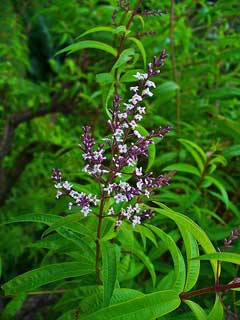 Description: This plant offers a wonderfully bright and lemony flavor perfect for a refreshing tea. Growing Conditions: It loves full sun and well-drained soil and is quite drought-tolerant once established, making it ideal for the California climate. Tea Usage: Harvest the leaves throughout the growing season for a refreshing, strongly lemon-flavored tea.
Description: This plant offers a wonderfully bright and lemony flavor perfect for a refreshing tea. Growing Conditions: It loves full sun and well-drained soil and is quite drought-tolerant once established, making it ideal for the California climate. Tea Usage: Harvest the leaves throughout the growing season for a refreshing, strongly lemon-flavored tea.
Lemongrass
Name: Cymbopogon citratus Description: Tall, grass-like perennial with aromatic leaves. Growing Conditions: Thrives in full sun and rich, moist, well-drained soil. Needs protection from frost. Tea Usage: East Indian and West Indian varieties are used for tea. Can be brewed fresh or dried. The entire plant can be used; leaves can be braided and dried for individual cup steeping.
Lemonade bush
Name: Rhus integrifolia and Sugar bush (Rhus ovata): Description: Native California shrubs with leathery leaves and small red berries. Growing Conditions: Drought-tolerant natives that prefer full sun and well-drained soil. Tea Usage: The tartness of these teas might not be for everyone on a daily basis, especially those with sensitive stomachs. However, if you enjoy the flavor, moderate regular use of the leaves is generally considered safe. Use the berries sparingly.
Mint
Description: Mints are incredibly easy to grow and come in a variety of flavors. Growing Conditions: They prefer partial shade to full sun and moist, well-drained soil, but are quite adaptable. Be mindful that mint can spread aggressively, so consider growing it in containers. Tea Usage: Simply harvest the leaves as needed for refreshing tea.
Mentha Species
Traditional Mint varieties
Corsican Mint
Mentha requienii - Benth.
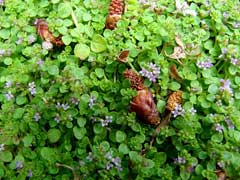 Description: Tiny ground-covering mint with miniature leaves. Growing Conditions: Prefers partial shade and consistently moist soil. Tea Usage: Makes a delicate, sweet mint tea.
Description: Tiny ground-covering mint with miniature leaves. Growing Conditions: Prefers partial shade and consistently moist soil. Tea Usage: Makes a delicate, sweet mint tea.
Round-Leaved Mint, Apple mint, Pineapple Mint
Name: Mentha suaveolens - Ehrh.
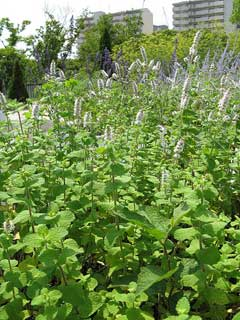 Description:
Mentha suaveolens is a rhizomatous perennial herb typically growing to a height of 1 to 3 feet (30-90 cm) with a similar spread. Its most distinctive feature is its broadly oval to nearly round leaves, which are softly hairy or woolly to the touch. The leaves are light green and have serrated edges. The stems are upright and can also be covered in fine hairs. In late summer and early autumn, the plant produces dense, terminal spikes of small flowers that range in color from white to pale pink or lilac. The plant emits a sweet, fruity fragrance, often described as apple-like, which is particularly noticeable when the leaves are bruised.
The cultivar ‘Pineapple Mint’ (Mentha suaveolens ‘Variegata’) is a popular variety known for its striking variegated foliage. Its leaves are typically green with irregular creamy-white margins or splashes, adding visual interest to the garden. The scent of Pineapple Mint is often described as a blend of mint with a subtle hint of pineapple.
Growing Conditions:
Mentha suaveolens is a vigorous and relatively easy-to-grow mint, but its spreading habit requires consideration.
Description:
Mentha suaveolens is a rhizomatous perennial herb typically growing to a height of 1 to 3 feet (30-90 cm) with a similar spread. Its most distinctive feature is its broadly oval to nearly round leaves, which are softly hairy or woolly to the touch. The leaves are light green and have serrated edges. The stems are upright and can also be covered in fine hairs. In late summer and early autumn, the plant produces dense, terminal spikes of small flowers that range in color from white to pale pink or lilac. The plant emits a sweet, fruity fragrance, often described as apple-like, which is particularly noticeable when the leaves are bruised.
The cultivar ‘Pineapple Mint’ (Mentha suaveolens ‘Variegata’) is a popular variety known for its striking variegated foliage. Its leaves are typically green with irregular creamy-white margins or splashes, adding visual interest to the garden. The scent of Pineapple Mint is often described as a blend of mint with a subtle hint of pineapple.
Growing Conditions:
Mentha suaveolens is a vigorous and relatively easy-to-grow mint, but its spreading habit requires consideration.
- Light: It thrives in full sun to partial shade. While it can tolerate some shade, a sunnier location generally promotes denser growth and potentially more intense aroma.
- Soil: This mint prefers moist, well-drained soil and can adapt to a range of soil types, including loamy and clay soils. It is tolerant of various pH levels, from slightly acidic to neutral and mildly alkaline. Good drainage is important to prevent root rot.
- Moisture: Mentha suaveolens has moderate to high water needs and prefers consistently moist conditions. It can even tolerate briefly wet soil, making it suitable for planting near ponds or in rain gardens, but prolonged waterlogging should be avoided.
- Hardiness: It is a hardy perennial, typically resilient in USDA Hardiness Zones 5 to 9. Pineapple Mint (Mentha suaveolens ‘Variegata’) may be slightly less cold-hardy, often recommended for zones 6 to 11.
- Spread: Like most mints, Mentha suaveolens spreads aggressively by underground rhizomes. To prevent it from becoming invasive, it is highly recommended to plant it in containers or use root barriers when planting directly in the ground.
- Maintenance: Regular harvesting not only provides a supply of fresh leaves but also helps to keep the plant in check and encourages bushier growth. Cutting back the plant after flowering can also help to manage its size and stimulate a flush of new leaves. Tea Usage: Round-Leaved Mint, Apple Mint, and Pineapple Mint are all excellent choices for making fragrant and flavorful herbal teas. The sweet, fruity notes make for a refreshing and soothing beverage.
- Flavor Profile: Tea made from Mentha suaveolens has a milder mint flavor compared to peppermint, with distinct fruity undertones often likened to apple. Pineapple Mint tea offers a similar mild mintiness with a subtle tropical hint.
- Preparation: Both fresh and dried leaves can be used for tea. Simply steep a handful of fresh leaves or a teaspoon or two of dried leaves in hot water for 5-10 minutes. The longer steeping time will result in a stronger flavor.
- Versatility: The mild, fruity flavor of Mentha suaveolens teas makes them enjoyable on their own or as a base for blending with other herbs or fruits. They can be served hot or iced.
Spearmint
Name: Mentha spicata - L.
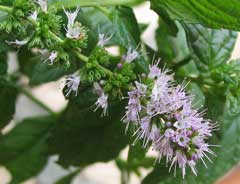 Description: Common garden mint with pointed leaves and a sweet flavor. Growing Conditions: Adaptable, prefers partial shade and consistent moisture. Tea Usage: The standard mint for tea, offering a sweet, cooling flavor.
Description: Common garden mint with pointed leaves and a sweet flavor. Growing Conditions: Adaptable, prefers partial shade and consistent moisture. Tea Usage: The standard mint for tea, offering a sweet, cooling flavor.
Moroccan Mint
Name: Mentha spicata var. Description: A variety of spearmint with a sweet, fresh flavor. Growing Conditions: Similar to spearmint, thrives with partial shade and regular water. Tea Usage: Commonly mixed with green tea or other herbs for traditional North African tea blends.
Peppermint
Name: Mentha piperita
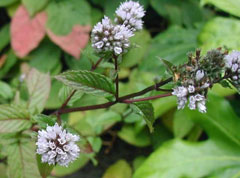 Description: Hybrid mint with a strong, cooling flavor. Growing Conditions: Likes partial shade and consistent moisture. Tea Usage: Makes a stronger, more medicinal tea than spearmint, good for digestive issues.
Description: Hybrid mint with a strong, cooling flavor. Growing Conditions: Likes partial shade and consistent moisture. Tea Usage: Makes a stronger, more medicinal tea than spearmint, good for digestive issues.
Corn Mint, Wild mint, Field mint
Name: Mentha arvensis
 Description: Low-growing native mint species. Growing Conditions: More adaptable to varying conditions than other mints. Tea Usage: Makes a milder mint tea with traditional medicinal uses.
Description: Low-growing native mint species. Growing Conditions: More adaptable to varying conditions than other mints. Tea Usage: Makes a milder mint tea with traditional medicinal uses.
Chocolate Mint
Name: Mentha x piperata f. citrata ‘Chocolate’ Chocolate Mint (Mentha x piperata f. citrata ‘Chocolate’): A Decadent Herb for Gardens and Teas
Description: Chocolate Mint typically features lush, dark green leaves that can display hints of burgundy or reddish-purple, especially when exposed to more sun. The stems are often dark brown or reddish, contributing to the “chocolate” in its name. The plant generally grows to a height of 1 to 2 feet with a similar spread, exhibiting a vigorous, spreading habit. In the summer, it produces small, whorled spikes of pinkish-purple to lavender flowers, which are attractive to pollinators. The key characteristic is the plant’s strong scent, a delightful blend of mint with distinct cocoa undertones, which translates into its flavor. Growing Conditions: Like many mint varieties, Chocolate Mint is relatively easy to grow but can spread enthusiastically if not contained.
- Light: It thrives in a range of lighting conditions, from full sun to partial shade. More sun can intensify the foliage color and potentially the flavor.
- Soil: Chocolate Mint prefers moist, well-drained soil. While it can tolerate a variety of soil types, including slightly acidic to neutral pH levels, enriching the soil with organic matter can promote healthier growth. It does not tolerate standing water.
- Watering: This mint variety has moderate to high water needs and prefers consistently moist soil. Avoid letting the soil dry out completely, especially in hotter conditions or when grown in containers.
- Hardiness: Chocolate Mint is quite hardy, typically performing well in USDA Hardiness Zones 5 through 9.
- Spread: Due to its rhizomatous nature, it can spread rapidly. To prevent it from taking over garden beds, it is often recommended to plant it in containers or use physical barriers in the ground. Tea Usage: Chocolate Mint is a favored herb for making fresh or dried herbal tea, offering a naturally sweet and refreshing beverage with a subtle chocolatey depth.
- Preparation: To make tea, fresh or dried leaves can be steeped in hot water. A general guideline is to use about two tablespoons of fresh leaves per liter of hot water, steeping for 4-6 minutes depending on desired strength. The flavor is often described as a blend of fresh mint with subtle notes of cocoa and vanilla.
- Flavor Profile: The tea provides a palate-cleansing mint finish with the unique addition of a gentle chocolatey aroma and taste. Some find the chocolate note more prominent in the aroma than the flavor.
- Culinary Uses: Beyond tea, Chocolate Mint leaves can be used fresh in desserts, fruit salads (especially with strawberries), cocktails, and even savory dishes to impart its distinctive flavor. Dried leaves can also be incorporated into baked goods and other recipes.
Monardella Species
Butterfly Mint Bush.
Name: Monardella antonina Description: A one-foot perennial covered with balls of pale purple with some pink flowers that attract butterflies. The foliage is gray-green with a good minty fragrance. Growing Conditions: Adapted to California’s climate, prefers well-drained soil and full sun. Tea Usage: If you use it for tea (excellent with Yerba Buena) use small amounts and do not steep long for it is strong. The flowering period is between July and December.
‘Russian River’ coyote mint
Name: Monardella villosa ‘Russian River’
 Description: Excellent evergreen perennial with small oval leaves that have a wonderfully fresh, minty smell. Bright purple-pink heads of small flowers adorn every stem tip in late spring and summer. Growing Conditions: Zones 8 to 11; full sun to partial shade; wide soil tolerance; size: 1 to 2 feet tall and 2 to 3 feet wide. Tea Usage: The aromatic leaves and flower heads can be used to make a refreshing, slightly bitter mint-flavored tea. Indigenous peoples of California traditionally used it to treat stomach upset, respiratory problems, and sore throats.
Description: Excellent evergreen perennial with small oval leaves that have a wonderfully fresh, minty smell. Bright purple-pink heads of small flowers adorn every stem tip in late spring and summer. Growing Conditions: Zones 8 to 11; full sun to partial shade; wide soil tolerance; size: 1 to 2 feet tall and 2 to 3 feet wide. Tea Usage: The aromatic leaves and flower heads can be used to make a refreshing, slightly bitter mint-flavored tea. Indigenous peoples of California traditionally used it to treat stomach upset, respiratory problems, and sore throats.
Mustang Mint.
Name: Monardella breweri Description: Native California mint species with aromatic foliage. Growing Conditions: Drought-tolerant, prefers full sun and well-drained soil. Tea Usage: Leaves can be used for a stronger mint tea with regional historical significance.
Agastache Species
Korean Mint
Name: Agastache rugosa
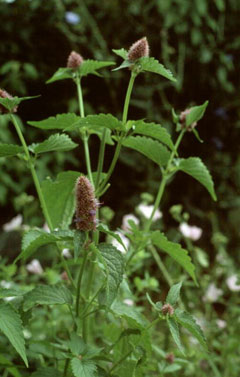 Description: Perennial herb with anise-scented leaves and lavender flower spikes. Growing Conditions: Prefers full sun and well-drained soil, drought-tolerant once established. Tea Usage: Makes an aromatic tea with digestive benefits.
Description: Perennial herb with anise-scented leaves and lavender flower spikes. Growing Conditions: Prefers full sun and well-drained soil, drought-tolerant once established. Tea Usage: Makes an aromatic tea with digestive benefits.
Horse Mint and Licorice Mint.
Name: Agastache urticifolia Description: Native perennial with tall flower spikes and aromatic foliage. Growing Conditions: Prefers full sun and well-drained soil, tolerates poor soil conditions. Tea Usage: Leaves make a flavorful tea with notes of mint and licorice.
Nasturtium
Name: Tropaeolum majus (non-native): Description: Annual with round leaves and bright edible flowers. Growing Conditions: Thrives in poor soil and full sun to partial shade. Tea Usage: The peppery flavor is likely too strong for regular daily consumption for most people. It’s better suited for occasional use.
Red Clover
Name: Trifolium pratense Description: Short-lived perennial with pink flower heads. Growing Conditions: Adaptable to various soils, prefers full sun to partial shade. Tea Usage: Flowers can be used fresh or dried for a mildly sweet tea traditionally used to support women’s health.
Rose
Name: Rosa spp. Description: Woody shrubs with fragrant flowers. Growing Conditions: Most varieties prefer full sun and well-drained, rich soil. Tea Usage: Petals can be used fresh or dried for a delicate, floral tea rich in vitamin C.
Rosemary
Name: Salvia rosmarinus, formerly Rosmarinus officinalis Description: Woody evergreen shrub with needle-like leaves. Growing Conditions: Very well-suited to Mediterranean climates, thriving in full sun and well-drained, even poor, soil. Tea Usage: While often used in cooking, rosemary makes an invigorating and flavorful tea with potential health benefits. Use fresh or dried leaves and sprigs.
Sage
Name: Salvia officinalis and other culinary sages Description: Woody perennial with gray-green leaves. Growing Conditions: Enjoys full sun and well-drained soil. Tea Usage: Common sage makes a slightly peppery and earthy tea that is often used for its potential medicinal properties. You can use fresh or dried leaves.
Sage, Kitchen sage, Small Leaf Sage, Garden Sage
Name: Salvia officinalis - L.
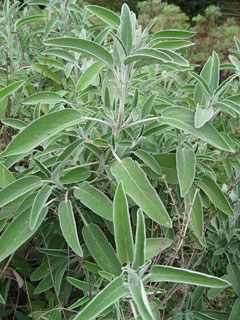 Description: Normal species that we associate with sage. Growing Conditions: Mediterranean native that prefers full sun and well-drained soil. Tea Usage: The aromatic leaves make a savory tea traditionally used for sore throats and digestive issues.
Description: Normal species that we associate with sage. Growing Conditions: Mediterranean native that prefers full sun and well-drained soil. Tea Usage: The aromatic leaves make a savory tea traditionally used for sore throats and digestive issues.
Black sage
Name: Salvia mellifera
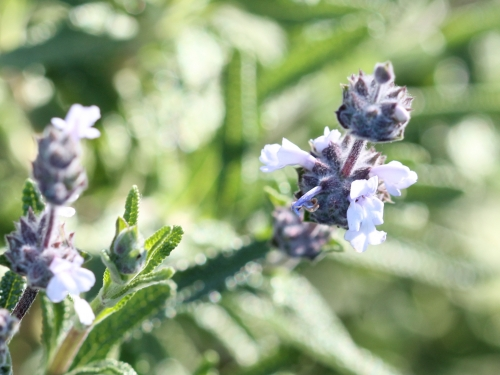 Description: Native California shrub with dark green leaves. Growing Conditions: Drought-tolerant, prefers full sun and well-drained soil. Tea Usage: Black sage tea has a nice flavor and aroma and is generally safe for regular consumption in moderate amounts.
Description: Native California shrub with dark green leaves. Growing Conditions: Drought-tolerant, prefers full sun and well-drained soil. Tea Usage: Black sage tea has a nice flavor and aroma and is generally safe for regular consumption in moderate amounts.
Blue Sage, Fragrant sage, Chaparral Sage
Name: Salvia clevelandii - (A.Gray.)Greene.
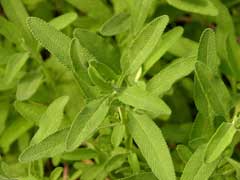 Description: Native California shrub with intensely aromatic gray-green leaves. Growing Conditions: Extremely drought-tolerant, prefers full sun and well-drained soil. Tea Usage: The leaves have a pleasant flavor and fragrance, they are a good substitute for sage in cooking and can be used for tea.
Description: Native California shrub with intensely aromatic gray-green leaves. Growing Conditions: Extremely drought-tolerant, prefers full sun and well-drained soil. Tea Usage: The leaves have a pleasant flavor and fragrance, they are a good substitute for sage in cooking and can be used for tea.
Hummingbird sage
Name: Salvia spathacea
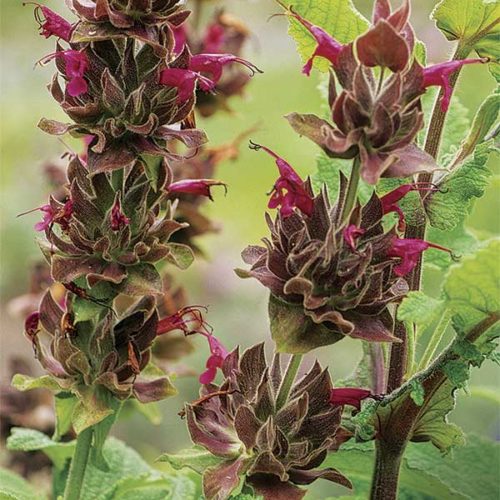 Description: Native sage species known for its vibrant red flowers. Each rosette of leaves sends up a large flower stalk (up to 3 feet tall) with whorls of many small magenta flowers. Both leaves and stalks are intensely fragrant.
Growing Conditions: Zones 7 to 10; shade is best or some sun with summer water; wide soil tolerance; size: 1 to 2 feet tall, slowly spreads to form colonies at least 4 feet wide. Very drought tolerant in shade, responds well to modest irrigation. Slowly spreading by underground runners.
Tea Usage: The leaves of this sage have a distinct fruity aroma and were used by Indigenous Californians to make a decongestant tea. The leaves can be steeped for both hot and cold tea. Its sweeter flavor compared to other sages makes it suitable for culinary uses like shortbread cookies.
Description: Native sage species known for its vibrant red flowers. Each rosette of leaves sends up a large flower stalk (up to 3 feet tall) with whorls of many small magenta flowers. Both leaves and stalks are intensely fragrant.
Growing Conditions: Zones 7 to 10; shade is best or some sun with summer water; wide soil tolerance; size: 1 to 2 feet tall, slowly spreads to form colonies at least 4 feet wide. Very drought tolerant in shade, responds well to modest irrigation. Slowly spreading by underground runners.
Tea Usage: The leaves of this sage have a distinct fruity aroma and were used by Indigenous Californians to make a decongestant tea. The leaves can be steeped for both hot and cold tea. Its sweeter flavor compared to other sages makes it suitable for culinary uses like shortbread cookies.
Mexican Scarlet Sage
Name: Salvia gesneriiflora ‘Tequila’ Description: Quickly reaches 10 feet tall and wide, though it can be kept smaller with pruning or trained into a smaller shrub. Growing Conditions: Adaptable to sun or shade, and is drought tolerant once established. Tea Usage: Leaves can be used sparingly for a strongly aromatic tea.
Purple Sage
Name: Salvia leucophylla Description: Native California shrub with purple-tinged gray foliage. Growing Conditions: Thrives in full sun and well-draining soil, such as sandy or rocky types, and is well-adapted to nutrient-poor soils. It is exceptionally drought-tolerant after establishment. Tea Usage: Leaves can be used for a fragrant tea with traditional medicinal uses.
Pineapple Sage
Name: Salvia elegans Description: Tender perennial with bright red flowers and pineapple-scented leaves. Growing Conditions: Prefers full sun and moderate water, less drought-tolerant than native sages. Tea Usage: Sweet and fruity flavors with a hint of mint and spice. Used as tea to calm nerves and aid digestion. Favorite of hummingbirds.
White Sage, Compact white sage
Name: Salvia apiana - Jeps.
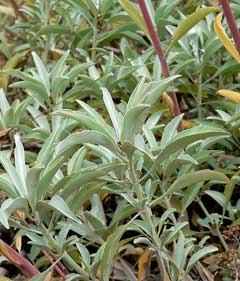 Description: Native California shrub with silvery-white foliage. Growing Conditions: Extremely drought-tolerant, prefers full sun and excellent drainage. Tea Usage: White Sage leaves are used sparingly in cooking, especially in teas and herbal preparations.
Description: Native California shrub with silvery-white foliage. Growing Conditions: Extremely drought-tolerant, prefers full sun and excellent drainage. Tea Usage: White Sage leaves are used sparingly in cooking, especially in teas and herbal preparations.
Sorrel
Name: Rumex acetosa Description: Perennial with tangy, arrow-shaped leaves. Growing Conditions: Prefers partial shade and moist, rich soil. Tea Usage: Leaves can be used fresh or dried for a tart, lemony tea rich in vitamin C.
Thyme
Name: Thymus vulgaris and other species Description: Low-growing aromatic perennial with tiny leaves. Growing Conditions: Very drought-tolerant and thrives in full sun and well-drained soil. Tea Usage: Thyme offers a slightly earthy and savory flavor that can be quite pleasant as a tea, especially when you have a cold. Use fresh or dried leaves and small stems.
Toothache Plant
Name: Acmella oleracea Description: Annual with round yellow-red flower heads that cause a numbing sensation. Growing Conditions: Prefers full sun and rich, moist soil. Tea Usage: Flowers and leaves can be used to make a numbing tea traditionally used for toothache and throat pain.
Vick’s Plant
Name: Plectranthus tomentosa Description: Fuzzy-leaved perennial with a camphor-like scent. Growing Conditions: Prefers partial shade and well-drained soil, drought-tolerant once established. Tea Usage: Leaves can be used to make a strongly aromatic tea traditionally used for congestion and respiratory issues.
White Mulberry
Name: Morus alba (non-native): Description: Deciduous tree with edible white to purple berries. Growing Conditions: Adaptable to various soils, prefers full sun to partial shade. Tea Usage: Mulberry leaf tea is typically mild and slightly sweet, making it a good option for regular consumption.
Yarrow
Name: Achillea millefolium Description: Perennial with feathery leaves and flat-topped flower clusters. Growing Conditions: Extremely adaptable, prefers full sun and well-drained soil. Tea Usage: Flowering tops can be used to make a bitter tea traditionally used for fever and inflammation.
Yerba Buena
Name: Clinopodium douglasii (syn. Satureja douglasii)
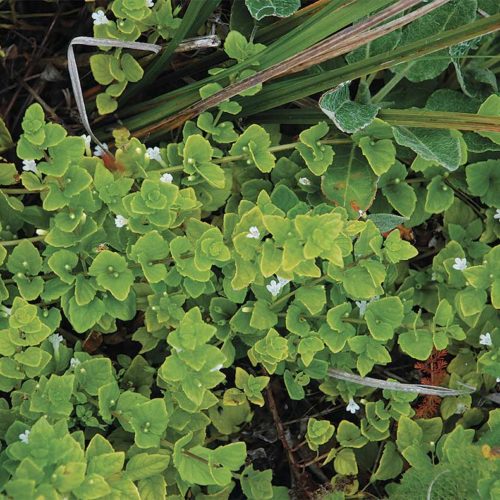 Description: Creeping and scrambling native herb with an intoxicatingly fresh lemon scent. Small white flowers from spring to summer are visited by bees and even draw hummingbirds to ground level. Growing Conditions: USDA Hardiness Zones 7 to 10; partial to full shade; seasonally or regularly moist soil; up to 6 inches tall and spreading to 4 feet wide or more. Loves regular water but can take long dry periods, especially when planted in shade. Survives short frosts. Tea Usage: Excellent kitchen herb traditionally used for tea. Creates extensive colonies over time as stems root where they touch.
Description: Creeping and scrambling native herb with an intoxicatingly fresh lemon scent. Small white flowers from spring to summer are visited by bees and even draw hummingbirds to ground level. Growing Conditions: USDA Hardiness Zones 7 to 10; partial to full shade; seasonally or regularly moist soil; up to 6 inches tall and spreading to 4 feet wide or more. Loves regular water but can take long dry periods, especially when planted in shade. Survives short frosts. Tea Usage: Excellent kitchen herb traditionally used for tea. Creates extensive colonies over time as stems root where they touch.
Yerba buena may be the finest tea herb that California has to offer. An intoxicatingly fresh lemon scent invigorates and soothes at once. Creeping and scrambling, its stems root where they touch, creating extensive colonies in time. Small white flowers from spring to summer are visited by bees and even draw hummingbirds to ground level. It is an excellent kitchen herb and ground cover under potted plants or among larger perennials. Yerba buena loves regular water but can take long dry periods, especially when planted in shade. It survives short frosts, occurring as far north as Vancouver, Washington. Is traditionally used for tea.
Yerba Santa
Name: Eriodictyon californicum
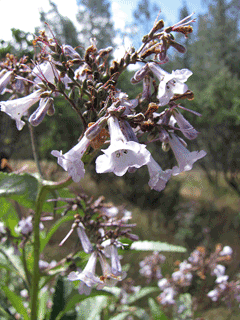 Description: California yerba santa is an evergreen shrub in the Borage family that grows in central and northern California and parts of Oregon. The plant’s long, narrow leaves, which can grow up to six inches, are coated in a sticky resin and often dusted with black fungi. In late spring to summer, it produces clusters of small, bell-shaped flowers that range from white to light purple.
Growing Conditions: Commonly found in chaparral, woodlands, and forested areas, thriving in dry, rocky soils. This hardy plant spreads by underground rhizomes, often forming dense thickets that compete with nearby vegetation. It can be aggressive in the garden, so care should be taken to manage its spread.
Tea Usage: With its fragrant and somewhat sweet flavor, Yerba Santa tea can be enjoyed regularly by many. Traditionally valued for its medicinal uses by Indigenous peoples, including as a remedy for respiratory issues and skin conditions.
California yerba santa (Eriodictyon californicum) is an evergreen shrub in the Borage family hat grows in central and northern California and parts of Oregon. It is commonly found in chaparral, woodlands, and forested areas, thriving in dry, rocky soils. This hardy plant spreads by underground rhizomes, often forming dense thickets that compete with nearby vegetation.
Description: California yerba santa is an evergreen shrub in the Borage family that grows in central and northern California and parts of Oregon. The plant’s long, narrow leaves, which can grow up to six inches, are coated in a sticky resin and often dusted with black fungi. In late spring to summer, it produces clusters of small, bell-shaped flowers that range from white to light purple.
Growing Conditions: Commonly found in chaparral, woodlands, and forested areas, thriving in dry, rocky soils. This hardy plant spreads by underground rhizomes, often forming dense thickets that compete with nearby vegetation. It can be aggressive in the garden, so care should be taken to manage its spread.
Tea Usage: With its fragrant and somewhat sweet flavor, Yerba Santa tea can be enjoyed regularly by many. Traditionally valued for its medicinal uses by Indigenous peoples, including as a remedy for respiratory issues and skin conditions.
California yerba santa (Eriodictyon californicum) is an evergreen shrub in the Borage family hat grows in central and northern California and parts of Oregon. It is commonly found in chaparral, woodlands, and forested areas, thriving in dry, rocky soils. This hardy plant spreads by underground rhizomes, often forming dense thickets that compete with nearby vegetation.